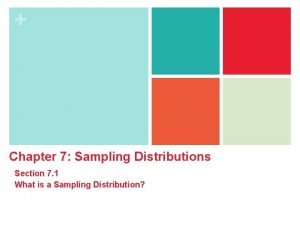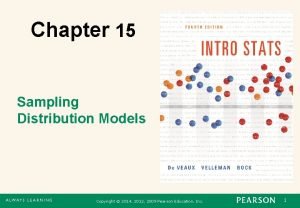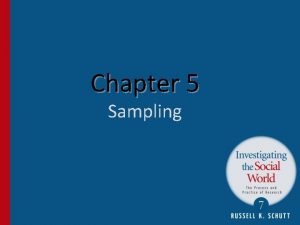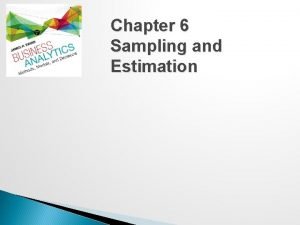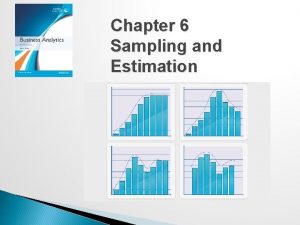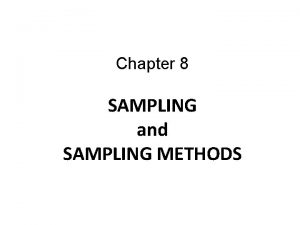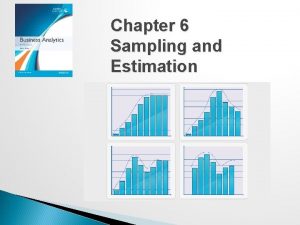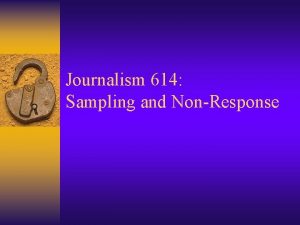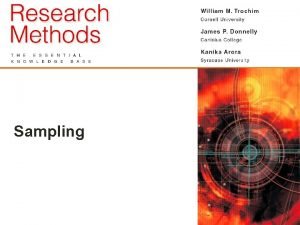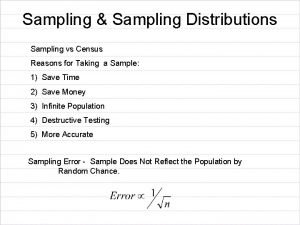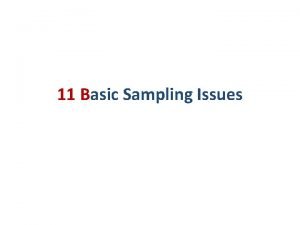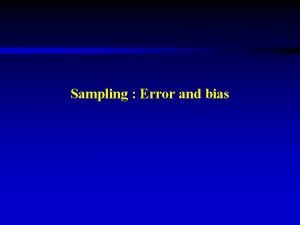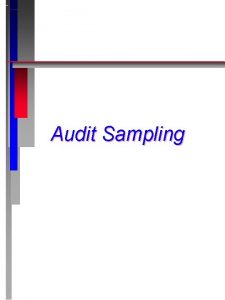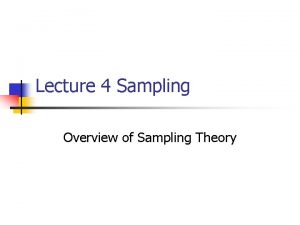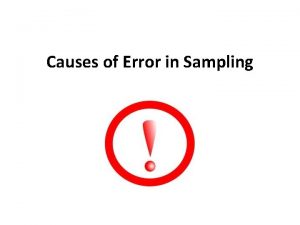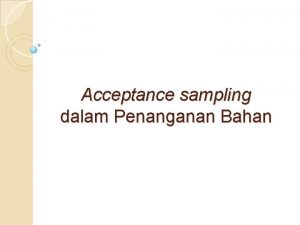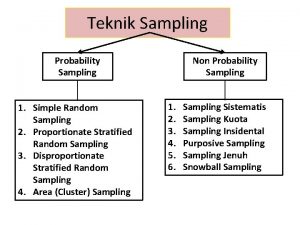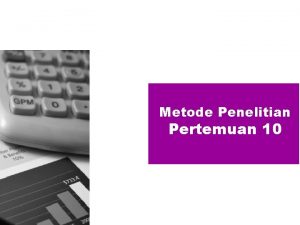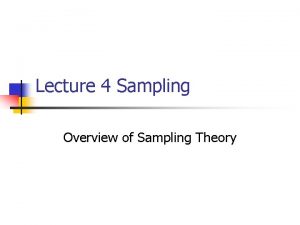Sampling Chapter 5 Introduction n Sampling n The




















































- Slides: 52

Sampling Chapter 5

Introduction n Sampling n The process of drawing a number of individual cases from a larger population n A way to learn about a larger population by obtaining information from a subset of a larger population n Example n Presidential polls are based upon samples of the population that might vote in an election


Introduction n Why Sample? n To learn something about a large group without having to study every member of that group n Time and cost n n Studying every single instance of a thing is impractical or too expensive Example n Census

Introduction n Why Sample? n Improve data quality n Obtain in-depth information about each subject rather than superficial data on all

Introduction n Why Sample? n We want to minimize the number of things we examine or maximize the quality of our examination of those things we do examine.

Introduction n Why Sample? n When is sampling unnecessary? n The number of things we want to sample is small n Data is easily accessible n Data quality is unaffected by the number of things we look at n Example § You are interested in the relationship between team batting average and winning percentage of major league baseball teams § There are only 30 major league teams § Data on team batting averages and winning percentages are readily available

Introduction n Why Sample? n Elements n A kind of thing the researcher wants to look at

Quiz – Question 1 Suppose you are interested in describing the nationality of Nobel prize-winning scientists. What would an element in your study be? What would the population be?

Introduction n Why Sample? n Population n The group of elements from which a researcher samples and to which she or he might like to generalize

Quiz – Question 2 n In the case of presidential elections in the United States the population is ____ and the elements of this population are _____.

Introduction n Why Sample? n Sample n A number of individual cases drawn from a larger population

Introduction n Sampling Frames, Probability versus Nonprobability Samples n Target population n A population of theoretical interest

Introduction n Sampling Frames, Probability versus Nonprobability Samples n Sampling frame or study population n The group of elements from which a sample is actually selected

Quiz – Question 3 The local television station conducted a study of TV viewers in the local viewing region. A list of all residential customers who subscribed to cable TV was obtained from the cable company. The list had 200, 000 households as subscribers. The TV station samples every 40 th household on the subscriber list. An interviewer visited each household and conducted the survey on viewing habits of household members. What is the sampling frame of the study?

Introduction n Sampling Frames, Probability versus Nonprobability Samples n A sample that has been drawn in a way that doesn’t give every member of the population a known chance of being selected

Introduction n Sampling Frames, Probability versus Nonprobability Samples n Probability n n A sample drawn in a way to give every member of the population a known (nonzero) chance of inclusion Probability samples are usually more representative than nonprobability samples of the populations from which they are drawn

Introduction n Sampling Frames, Probability versus Nonprobability Samples n Biased Samples n A sample that is not representative from the population which it is drawn § Probability samples are LESS likely to be biased samples

Introduction n Sampling Frames, Probability versus Nonprobability Samples n Generalizability n The ability to apply the results of a study to groups or situations beyond those actually studied § A probability sample tends to be more generalizable because it increases the chances that samples are representative of the populations from which they are drawn.

Introduction STOP AND THINK n Can you think why researchers haven’t used cell phone numbers in polling until recently? n What problem may result from only using landline numbers?

Focal Research n “Calling Cell Phones in ’ 08 Pre-Election Polls” n Examines the hypothesis than Barack Obama fared better in probability samples including landline- and cell phone-users than in samples including landline users alone.

Focal Research n Thinking about ethics n Because of the sampling technique employed, the Pew pollsters never knew the identity of their respondents, so respondent anonymity was never in danger. n Moreover, participation in the survey was voluntary.

Sources of Error Associated with Sampling n Types of Survey Error – due to sampling n n n Coverage Error Nonresponse Error Sampling Error

Sources of Error Associated with Sampling n Coverage Errors n Errors that results from differences between the sampling frame and the target population

Sources of Error Associated with Sampling n Coverage Errors n People are typically left out, if samples are drawn from phone books, car registrations, etc… n Unlisted Phone Numbers – one of the greatest potentials for coverage error § Pollsters use random digit dial to avoid unlisted numbers § Random-digit dialing § A method for selecting participants in a telephone survey that involves randomly generating telephone numbers n What are potential future problems, with using telephone listings to draw a sample?

Sources of Error Associated with Sampling n Coverage Errors n Parameter- A summary of a variable characteristic in a population

Sources of Error Associated with Sampling n Coverage Errors n Statistic-A summary of a variable in a sample

Sources of Error Associated with Sampling n Nonresponse Error n Errors that result from differences between nonreponders and responders to a survey

Stop and Think n What kinds of people might not be home to pick up the phone in the early evening when most survey organizations make their calls? n What kinds of people might refuse to respond to telephone polls, even if they were contacted?

Sources of Error Associated with Sampling n Sampling Error n Any difference between the characteristics of a sample and the characteristics of the population from which the sample is drawn

Sources of Error Associated with Sampling n Sampling Error n Sampling Variability n The variability in sample statistics that occurs when different samples are drawn from the same population

Sources of Error Associated with Sampling n Margin of error n Suggestion of how far away the actual population parameter is likely to be from the statistic

Types of Probability Sampling l l l Simple Random Sampling Systematic Sampling Stratified Sampling Cluster Sampling Multistage Sampling

Types of Probability Sampling n Simple Random Sampling n A probability sample in which every member of a study population has been given an equal chance of selection n n One way to draw a simple random sample, is to put all possibilities on paper, cut them up, and then draw a sample from a hat Research Randomizer (http: //randomizer. org)

Types of Probability Sampling n Simple Random Sampling n Sampling distribution n n The distribution of a sample statistic A visual display of the samples

Types of Probability Sampling

Types of Probability Sampling n Systematic Sampling A probability sampling procedure that involves selecting every kth element from a list of population elements, after the first element has been randomly selected n Example n n n Divide the total number of elements by the number you want in your sample 24/6 = 4 Randomly select a number between 1 and 4 and then select every 4 th element from that number

Types of Probability Sampling n Systematic Sampling n Selection interval n The distance between the elements selected in a sample Selection Interval (k) = population size sample size

Types of Probability Sampling n Stratified Sampling n A probability sampling procedure that involves dividing the population in groups or strata defined by the presence of certain characteristics and then random sampling from each stratum n Example n If you had a population that was 10% women and you want a sample that is also 10% women

Types of Probability Sampling n Stratified Sampling n Steps to draw a stratified random sample 1. 2. 3. Group the study population into strata or into groups that share a given characteristic Enumerate each group separately Randomly sample within each strata

Types of Probability Sampling n Cluster Sampling n A probability sampling procedure that involves randomly selecting clusters of elements from a population and subsequently selecting every element in each selected cluster for inclusion in the sample n Cluster sampling is an option if data collection involves visits to sites that are far apart

Types of Probability Sampling n Cluster Sampling n Example n You are conducting a study of Kentucky high school students § You could obtain a list of all high school students in the state and complete random sampling n A cluster sample would be more practical § Obtain a list of all high schools in Kentucky § Random sample the high schools from the list § Obtain a list of students for each high school selected and then contact each of those students

Types of Probability Sampling n Multistage Sampling n A probability sampling procedure that involves several stages, such as randomly selecting clusters from a population, then randomly selecting elements from each of the clusters

Types of Probability Sampling n Multistage Sampling n Example n Random Digit Dial § Stage 1: Areas Codes randomly sampled § Stage 2: Three digit local exchanges randomly sampled § Stage 3: Last four digits randomly sampled § Stage 4: Asking the person who answer the phone for the appropriate person you want to interview

Quiz – Question 4 You want to draw a sample of the employees at a large university ensuring that in your sample you have people represented from all personnel categories including administrators, faculty, secretarial staff, cleaning staff, mail room staff, technicians, and students. What type of probability sample would be best?

Types of Nonprobabilty Sampling l l Purposive Sampling Quota Sampling Snowball Sampling Convenience Sampling

Types of Nonprobability Sampling n Purposive Sampling n A nonprobability sampling procedure that involves selecting elements based on a researcher's judgment about which elements will facilitate his or her investigation

Types of Nonprobability Sampling n Quota Sampling n A nonprobability sampling procedure that involves describing the target population in terms of what are thought to be relevant criteria and then selecting sample elements to represent the “relevant” subgroups in proportion to their presence in the target population

Types of Nonprobability Sampling n Snowball Sampling n A nonprobability sampling procedure that involves using members of the group of interest to identify other members of the group

Types of Nonprobability Sampling n Convenience Sampling n A nonprobability sampling procedure that involves selecting elements that are readily accessible to the researcher n Sometimes called an available-subjects sample

Choosing a Sampling Technique n Is it desirable to sample at all or can the whole population be used? n Is it important to generalize to a larger population? n Political preference polls n Do you have the access and ability to perform probability sampling? n Major considerations n n Methods Theory Practicality Ethics

Summary n Sampling is a means to an end. n We sample because studying every element in our population is frequently beyond our means or would jeopardize the quality of our. n On the other hand, we don’t need to sample when studying every member of our population is feasible.
 Probability vs non probability sampling
Probability vs non probability sampling Multistage sampling
Multistage sampling Cluster sampling vs stratified random sampling
Cluster sampling vs stratified random sampling Contoh observasi event sampling
Contoh observasi event sampling Cluster random sampling vs stratified
Cluster random sampling vs stratified Sample definition research
Sample definition research Natural sampling vs flat top sampling
Natural sampling vs flat top sampling Hình ảnh bộ gõ cơ thể búng tay
Hình ảnh bộ gõ cơ thể búng tay Frameset trong html5
Frameset trong html5 Bổ thể
Bổ thể Tỉ lệ cơ thể trẻ em
Tỉ lệ cơ thể trẻ em Voi kéo gỗ như thế nào
Voi kéo gỗ như thế nào Thang điểm glasgow
Thang điểm glasgow Bài hát chúa yêu trần thế alleluia
Bài hát chúa yêu trần thế alleluia Các môn thể thao bắt đầu bằng tiếng nhảy
Các môn thể thao bắt đầu bằng tiếng nhảy Thế nào là hệ số cao nhất
Thế nào là hệ số cao nhất Các châu lục và đại dương trên thế giới
Các châu lục và đại dương trên thế giới Công thức tính độ biến thiên đông lượng
Công thức tính độ biến thiên đông lượng Trời xanh đây là của chúng ta thể thơ
Trời xanh đây là của chúng ta thể thơ Mật thư tọa độ 5x5
Mật thư tọa độ 5x5 101012 bằng
101012 bằng độ dài liên kết
độ dài liên kết Các châu lục và đại dương trên thế giới
Các châu lục và đại dương trên thế giới Thơ thất ngôn tứ tuyệt đường luật
Thơ thất ngôn tứ tuyệt đường luật Quá trình desamine hóa có thể tạo ra
Quá trình desamine hóa có thể tạo ra Một số thể thơ truyền thống
Một số thể thơ truyền thống Cái miệng xinh xinh thế chỉ nói điều hay thôi
Cái miệng xinh xinh thế chỉ nói điều hay thôi Vẽ hình chiếu vuông góc của vật thể sau
Vẽ hình chiếu vuông góc của vật thể sau Biện pháp chống mỏi cơ
Biện pháp chống mỏi cơ đặc điểm cơ thể của người tối cổ
đặc điểm cơ thể của người tối cổ Ví dụ giọng cùng tên
Ví dụ giọng cùng tên Vẽ hình chiếu đứng bằng cạnh của vật thể
Vẽ hình chiếu đứng bằng cạnh của vật thể Vẽ hình chiếu vuông góc của vật thể sau
Vẽ hình chiếu vuông góc của vật thể sau Thẻ vin
Thẻ vin đại từ thay thế
đại từ thay thế điện thế nghỉ
điện thế nghỉ Tư thế ngồi viết
Tư thế ngồi viết Diễn thế sinh thái là
Diễn thế sinh thái là Các loại đột biến cấu trúc nhiễm sắc thể
Các loại đột biến cấu trúc nhiễm sắc thể Số nguyên tố là
Số nguyên tố là Tư thế ngồi viết
Tư thế ngồi viết Lời thề hippocrates
Lời thề hippocrates Thiếu nhi thế giới liên hoan
Thiếu nhi thế giới liên hoan ưu thế lai là gì
ưu thế lai là gì Sự nuôi và dạy con của hươu
Sự nuôi và dạy con của hươu Khi nào hổ con có thể sống độc lập
Khi nào hổ con có thể sống độc lập Sơ đồ cơ thể người
Sơ đồ cơ thể người Từ ngữ thể hiện lòng nhân hậu
Từ ngữ thể hiện lòng nhân hậu Thế nào là mạng điện lắp đặt kiểu nổi
Thế nào là mạng điện lắp đặt kiểu nổi Chapter 7 sampling distributions
Chapter 7 sampling distributions Chapter 17 sampling distribution models
Chapter 17 sampling distribution models Ap stats chapter 17 sampling distribution models
Ap stats chapter 17 sampling distribution models Ap stats chapter 17 sampling distribution models
Ap stats chapter 17 sampling distribution models

















































